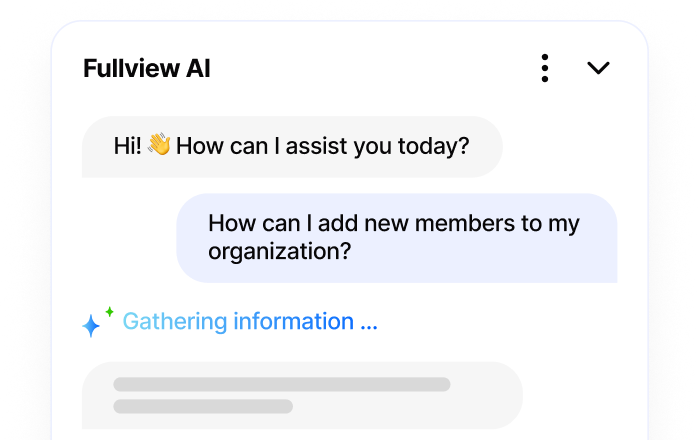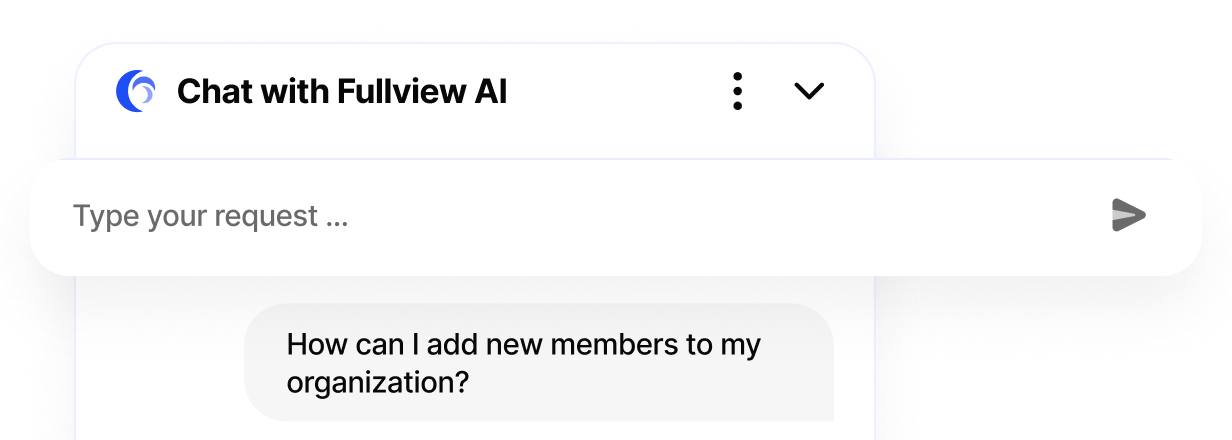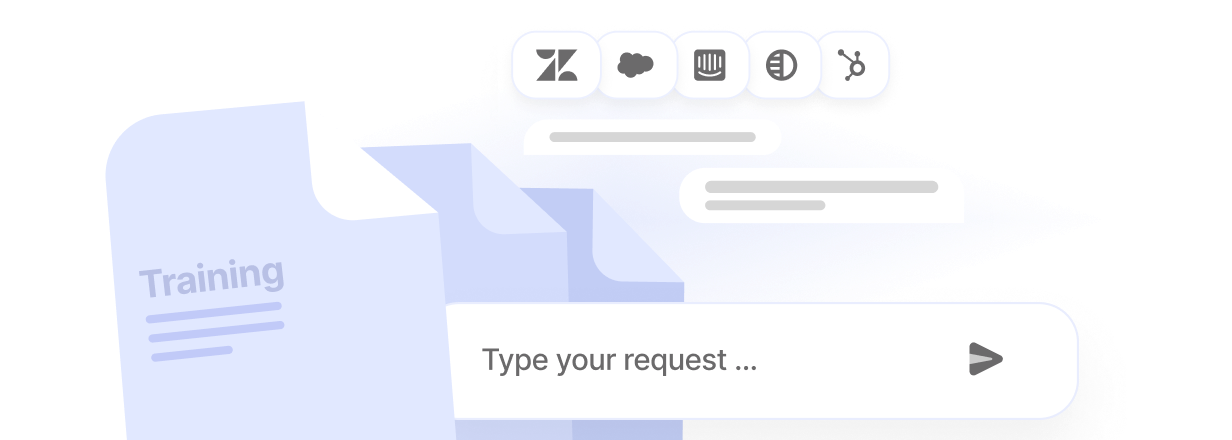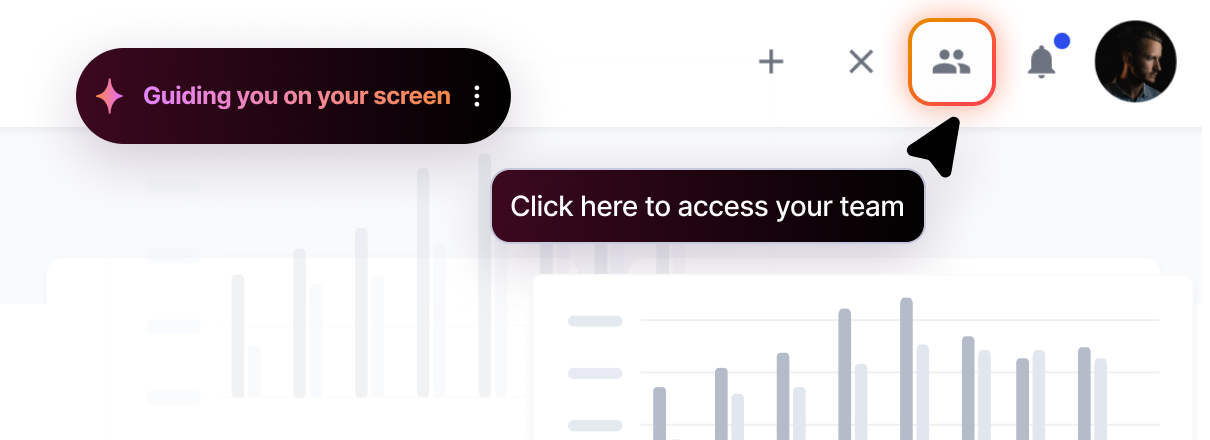The customer support landscape is undergoing a seismic shift. Traditional chatbots that could barely handle basic FAQs are being replaced by autonomous AI agents capable of navigating applications, solving complex issues, and taking real action on behalf of users. These aren't just smarter chatbots. They're fundamentally different systems that can see, understand, and interact with software interfaces just like human agents do.
The results speak for themselves: AI agents cut mean time to resolution by 42% while reducing support costs by up to 60%. Companies that embrace this autonomous approach don't just handle tickets faster. They transform the entire customer experience from reactive problem-solving to proactive issue prevention. This shift from "talk" to "do" is becoming the new standard for software companies that want to scale without sacrificing service quality.
Platforms like Fullview exemplify this do-rather-than-talk philosophy, combining real-time co-browsing with autonomous action capabilities to resolve issues instantly without manual setup requirements.
What Are AI Support Agents?
AI support agents are autonomous software systems that combine artificial intelligence with the ability to take direct action within applications. Unlike traditional chatbots that can only respond with text or suggest solutions, these agents can actually perform tasks: clicking buttons, filling forms, navigating interfaces, and completing multi-step processes on behalf of users.
At their core, AI support agents represent a convergence of three critical technologies. Large language models (LLMs) provide natural language understanding and conversation capabilities. Computer vision enables agents to "see" and interpret user interfaces, identifying buttons, forms, and interactive elements. Autonomous action engines allow agents to securely interact with applications—clicking, typing, and navigating just like a human would.
This combination creates what industry experts call "agentic AI": systems that don't just process and respond to information, but actively take steps to resolve issues. The distinction is crucial: where traditional AI customer support relies on users to implement suggested solutions, autonomous agents implement solutions directly.
Key Terms:
- Session Replay: A video-like recording of user sessions that captures every click, scroll, and interaction
- Guardrails: Policy rules that restrict agent actions to approved workflows and prevent unauthorized operations
- Co-browsing: A joint navigation session where support agents and users share control of the same interface
From Chatbots to Autonomous Agents
The evolution of customer support automation follows a clear three-stage progression, each addressing the limitations of its predecessor.
Stage 1: Rule-Based Bots (2010-2018) Early chatbots operated on decision trees and keyword matching. They could handle simple, predictable interactions but failed when users deviated from scripts or asked complex questions. The result? Endless loops of "I don't understand" and frustrated customers demanding human agents.
Stage 2: Conversational Chatbots (2018-2023) The introduction of natural language processing transformed bots into more sophisticated conversational partners. They could understand context, handle follow-up questions, and provide more nuanced responses. However, they remained fundamentally reactive. They were capable of explaining problems but unable to solve them directly.
Stage 3: Autonomous In-App Agents (2023-Present) Today's AI agents break through the conversation barrier. They don't just talk about solutions. They implement them. When a user struggles with a software configuration, the agent doesn't just explain the steps; it performs them directly within the user's session.
This evolution reflects changing user expectations. With AI agent adoption growing at a 45%+ compound annual growth rate, autonomy has become table stakes rather than a competitive advantage. Users increasingly expect support that resolves issues instantly rather than merely explaining how to resolve them.
Core Components: Language, Vision and Action
Modern AI support agents operate through three integrated technical layers, each contributing essential capabilities to the autonomous experience.
Language Processing handles the conversational interface—understanding user intent, maintaining context across interactions, and generating appropriate responses. Advanced LLMs can detect subtle cues like frustration or urgency, adjusting their approach accordingly.
Computer Vision enables agents to "see" user interfaces just like humans do. This technology identifies clickable elements, reads form fields, and understands visual layouts. The result is zero-setup guidance that works across any application without requiring special integrations—a capability that platforms like Fullview have perfected for seamless deployment across diverse software environments.
Autonomous Action represents the breakthrough capability that separates modern agents from their predecessors. Through secure automation protocols, agents can click buttons, fill forms, navigate menus, and complete complex workflows all within the user's actual session.
High-Impact Use Cases in SaaS Support
AI support agents excel in scenarios that combine complexity with repetition. These are situations where human expertise is valuable but the underlying tasks follow predictable patterns.
Onboarding Acceleration: New users often struggle with initial setup processes that involve multiple configuration steps. Autonomous agents can auto-complete user profiles, configure settings based on best practices, and guide users through integration processes in real-time.
Configuration Troubleshooting: When users encounter software configuration errors, agents can access console logs, identify the specific issue, and implement fixes directly. This eliminates the typical back-and-forth of "try this setting" conversations.
Data-Intensive Operations: Tasks like report generation, data exports, or billing adjustments often require navigating multiple screens and forms. Agents can complete these processes end-to-end while keeping users informed of progress.
Integration Support: Setting up third-party integrations typically involves API keys, webhook configurations, and testing procedures. Agents can automate much of this process while ensuring security protocols are followed.
Real-world results demonstrate the impact: Companies like Personio and Pipedrive using advanced AI support platforms report a 15% reduction in escalations to human agents, with average resolution times dropping from hours to minutes for routine issues. Fullview's customer base, which includes companies like Apollo and Alcon, consistently sees similar improvements in first-contact resolution rates.
Must-Have Features Checklist
When evaluating AI support agent platforms, ensure these core capabilities are included:
✓ Require SOC2-compliant data storage - Essential for enterprise security standards and customer trust
✓ Demand real-time session replay integration - Provides visual context that dramatically improves diagnosis speed
✓ Verify autonomous in-app action capabilities - Distinguishes true agents from sophisticated chatbots
✓ Confirm multi-platform UI recognition - Ensures agents work across your entire software ecosystem
✓ Validate comprehensive data masking - Protects sensitive information during support sessions
✓ Test API integration flexibility - Enables seamless connection with existing helpdesk and CRM systems
✓ Review confidence threshold controls - Allows fine-tuning of when agents act vs. escalate to humans
✓ Assess customizable guardrails - Provides control over which actions agents can perform
✓ Examine analytics and reporting depth - Delivers insights needed to optimize agent performance
✓ Confirm 24/7 deployment capabilities - Maximizes the value of autonomous support
Autonomous In-App Action and Visual Guidance
The defining characteristic of modern AI support agents is their ability to perform actions rather than merely suggesting them. This capability manifests through several key technologies.
Multi-Cursor Control allows agents to take control of user interfaces while maintaining transparency about their actions. Users can observe every click and interaction, creating trust through visibility rather than opacity.
Step-by-Step Visual Highlighting provides real-time guidance even when agents aren't taking direct action. Elements are highlighted as they become relevant, creating an intuitive learning experience that reduces future support needs.
Intelligent Form Autofill combines user data with contextual understanding to complete complex forms automatically. This eliminates tedious data entry while ensuring accuracy through validation protocols.
The distinction between autonomous action and mere suggestion is crucial. Traditional support might say "click the settings button in the upper right." Autonomous agents simply click it, then explain what they've done and why.
Co-browsing represents the hybrid approach where human agents and AI systems share control. This provides the benefits of automation while maintaining human oversight for complex or sensitive operations.
Real-Time Context: Replays, Console Logs, User Data
Effective AI support requires comprehensive situational awareness. Modern agents integrate multiple data streams to understand not just what users are asking, but what they're experiencing.
Session Replay Technology captures complete user interactions, creating a visual record of exactly what happened leading up to a support request. This eliminates the guesswork that characterizes traditional support tickets where users struggle to describe their actions.
Live Console Monitoring provides technical insight into application errors, API failures, and performance issues. When combined with user actions, this creates a complete picture of both symptoms and underlying causes.
Integrated User Data connects support interactions with customer profiles, usage patterns, and historical issues. This context enables agents to anticipate needs and proactively address potential problems.
The data flow architecture typically follows this pattern: User Browser → Real-time Data Collection → AI Analysis Engine → Support Dashboard Integration. This creates a unified view that combines user experience with technical diagnostics.
Popular integrations include error monitoring platforms like Datadog and Sentry, which provide additional technical context. Leading platforms like Fullview offer seamless integration with major helpdesks including Intercom, Zendesk, and Salesforce Service Cloud, ensuring agents can access comprehensive context regardless of existing support infrastructure. The key is ensuring all data streams update in real-time rather than relying on periodic syncing that can miss crucial details.
Security, Compliance and Data Masking
Enterprise adoption of AI support agents requires robust security measures that protect both customer data and business operations.
Essential Certifications include GDPR compliance for European operations, SOC2 Type II for enterprise security standards, PCI-DSS for payment processing, and HIPAA Business Associate Agreements for healthcare-related services.
Field-Level Data Masking protects sensitive information during support sessions. Advanced systems can identify and redact personal information, payment details, and proprietary data in real-time without disrupting the support experience.
Example Masking Policy: "Automatically mask the first six and last four digits of credit card numbers, replace Social Security numbers with asterisks, and blur proprietary code repositories during screen sharing sessions."
Encryption Standards should cover data in transit and at rest, with end-to-end encryption for all support communications. Zero-knowledge architectures ensure that even platform providers cannot access sensitive customer data.
Access Controls must include role-based permissions, session monitoring, and audit trails. Every action taken by AI agents should be logged and reviewable for compliance purposes.
Metrics That Prove ROI
What gets measured gets funded, especially when it comes to AI support agent implementations. Establishing clear metrics ensures continued investment and identifies optimization opportunities.
Benchmark ranges vary by industry, but SaaS companies typically see the most dramatic improvements across key performance indicators.
CSAT, NPS and First-Contact Resolution
Customer Satisfaction (CSAT) measures post-interaction satisfaction on a 1-5 or 1-10 scale. Calculate as: (Number of satisfied responses / Total responses) × 100
Net Promoter Score (NPS) gauges likelihood to recommend on a 0-10 scale. Calculate as: % Promoters (9-10) - % Detractors (0-6)
First-Contact Resolution tracks issues solved in the initial interaction. Calculate as: (Tickets resolved without escalation / Total tickets) × 100
Autonomous agents typically lift first-contact resolution rates by 25-40%, as they can complete tasks that previously required multiple human interactions or follow-up communications.
Mean Time to Resolution and Ticket Deflection
Mean Time to Resolution (MTTR) measures average time from ticket creation to closure. Industry averages for SaaS companies hover around 18 hours, while AI-powered support often achieves sub-4-hour resolution times.
Ticket Deflection quantifies issues solved without human intervention. Calculate as: (Autonomous resolutions / Total support requests) × 100
Leading implementations achieve 30-50% ticket deflection rates, significantly reducing load on human support teams while maintaining service quality.
Staffing Savings and Efficiency Ratios
Annualized Cost Avoidance can be calculated by estimating reduced headcount growth needs. If AI agents handle 40% of tickets, a team that would have grown from 10 to 15 agents might only need to grow to 12, saving three full-time salaries plus benefits.
Agent-to-Human Assist Ratio represents an emerging metric: the number of user issues solved autonomously per live human agent. High-performing implementations achieve ratios of 3:1 or higher, meaning each human agent's capacity is effectively tripled through AI assistance.
Pricing Models and Total Cost of Ownership
Sticker price rarely equals true cost when it comes to AI support agent platforms. Understanding the full economic picture requires examining both obvious and hidden expenses.
Subscription Versus Usage-Based Pricing
Subscription Models offer predictable monthly or annual costs based on agent seats, user volume, or feature tiers. Benefits include budget predictability and unlimited usage within plan limits. Drawbacks include paying for unused capacity during slower periods.
Usage-Based Pricing charges per interaction, resolution, or API call. This aligns costs with value but can create unpredictable expenses during high-volume periods. Many organizations prefer a blended approach: base subscription plus variable usage fees.
Optimization Tip: Consider hybrid pricing that combines a base seat fee with variable volume pricing. This provides budget predictability while allowing for growth without dramatic cost spikes.
Hidden Costs: Implementation, Training and Maintenance
Beyond platform fees, budget for these often-overlooked expenses:
Integration Engineering: 40-80 hours for complex helpdesk integrations, API customizations, and workflow setup Compliance Audits: $5,000-15,000 for initial security assessments in regulated industries
Ongoing Optimization: 5-10 hours monthly for prompt tuning, guardrail adjustments, and performance optimization Training and Change Management: Internal team training, process documentation, and user adoption programs
Planning Recommendation: Set aside 10-20% of year-one platform spend for continuous optimization and unexpected integration needs.
Build-Vs-Buy Breakeven Calculator
Development Costs: $200,000-500,000 for initial AI agent development including NLP, computer vision, and action automation capabilities
Maintenance Costs: $50,000-100,000 annually for ongoing development, security updates, and feature enhancements
Opportunity Cost: 6-18 months of delayed deployment while building internal solutions
Sample Scenario: A team considering building vs. buying at $50,000 annual platform cost would reach breakeven in under 12 months when factoring in development time, maintenance overhead, and delayed value realization.
Evaluation Framework for Enterprise Teams
Structured evaluation prevents costly mistakes and ensures chosen platforms align with both immediate needs and long-term strategy.
Integration Checklist for Zendesk, Intercom and APIs
Required Helpdesk Events:
- Create ticket with automated categorization
- Update ticket status and priority in real-time
- Attach session replay links and console logs
- Sync conversation history and resolution notes
- Trigger escalation workflows based on complexity
API Fallback Requirements: For organizations using custom or less common CRM systems, ensure platforms provide robust REST APIs that support:
- Webhook notifications for agent actions
- Custom field mapping and data synchronization
- Real-time status updates and progress tracking
Pilot, Rollout and Continuous Improvement Roadmap
Phase 1: 30-Day Pilot
- Deploy with limited use cases (e.g., onboarding support only)
- Monitor KPIs: resolution time, user satisfaction, escalation rate
- Gather feedback from both users and support agents
- Document lessons learned and optimization opportunities
Phase 2: Staged Rollout
- Expand to additional use cases based on pilot results
- Implement learnings from initial deployment
- Monitor volume scaling and performance impact
- Refine guardrails and confidence thresholds
Phase 3: Optimization and Scale
- Full deployment across all applicable support scenarios
- Monthly prompt audits and performance tuning
- Advanced analytics implementation and reporting
- Long-term roadmap alignment with vendor development
Recommended Audit Cadence: Monthly guardrail reviews, quarterly prompt optimization, annual strategic roadmap assessment.
Vendor Comparison Scorecard Template
Use this weighted scoring framework (1-5 scale) to objectively evaluate platforms:
Feature Depth (30% weight)
- Autonomous action capabilities
- UI recognition accuracy
- Integration breadth and flexibility
- Customization and configuration options
Security Posture (25% weight)
- Compliance certifications
- Data protection measures
- Access controls and audit capabilities
- Incident response procedures
Total Cost of Ownership (25% weight)
- Platform pricing competitiveness
- Implementation and setup costs
- Ongoing maintenance requirements
- Hidden fees and usage overages
Roadmap Alignment (20% weight)
- Product development velocity
- Feature request responsiveness
- Strategic vision alignment
- Long-term viability and funding
Scoring Visualization: Create a color-coded heat map where 4-5 scores appear green, 3 scores yellow, and 1-2 scores red for immediate visual assessment.
Frequently Asked Questions
How long does an AI support agent take to deploy?
Most SaaS teams deploy pre-built AI support agents within 1-3 days once API credentials and workflow scripts are connected. The process typically involves: helpdesk integration setup (Day 1), initial configuration and testing (Day 2), and live deployment with monitoring (Day 3). Custom integrations or complex workflow requirements may extend deployment to 1-2 weeks.
Will an AI agent replace human support reps?
AI agents handle repetitive tasks and routine issues, freeing human agents for complex problem-solving, relationship building, and strategic initiatives. Most implementations see 30-50% ticket volume reduction without eliminating jobs. Instead, human agents focus on higher-value activities that require empathy, creativity, and complex reasoning.
How do confidence thresholds and guardrails work?
Confidence thresholds set the minimum score an AI response must achieve before taking action (typically 85-95%). Below this threshold, agents escalate to humans or ask clarifying questions. Guardrails define approved actions and restrict unauthorized operations, for example, allowing password resets but preventing account deletions, or permitting configuration changes within specific parameters.
What does GDPR and HIPAA compliance look like?
GDPR compliance requires data minimization (collecting only necessary information), explicit consent mechanisms, right-to-delete capabilities, and data processing transparency. HIPAA compliance demands signed Business Associate Agreements, encrypted data handling, access controls, and comprehensive audit trails. Both require regular compliance audits and incident response procedures.
Can we customize the agent's brand voice and actions?
Yes, modern platforms allow extensive customization of both communication style and operational capabilities. Brand voice customization includes tone adjustment (formal vs. casual), terminology preferences, and response structure. Action customization involves defining which workflows agents can execute, setting approval requirements for sensitive operations, and creating industry-specific automation patterns. Most platforms provide no-code configuration panels alongside API access for advanced customization.
Ready to transform your support organization with autonomous AI agents? The shift from reactive support to proactive problem-solving represents more than just technological advancement. It's a fundamental reimagining of customer experience. Start with a focused pilot, measure impact rigorously, and scale based on proven results. The companies that master this transition will set the standard for customer support in the AI era.








.webp)
